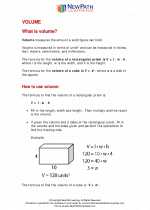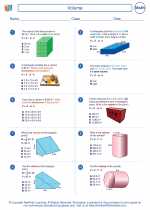Prism: Exploring the Basics
A prism is a three-dimensional shape that has two parallel and congruent polygonal bases, and rectangular or parallelogram-shaped sides. The most common type of prism is a rectangular prism, which has six faces, all of which are rectangles. Other types of prisms include triangular prisms, pentagonal prisms, hexagonal prisms, and so on, depending on the shape of their bases.
Key Features of a Prism:
- Bases: The two parallel and congruent polygonal faces at the ends of the prism.
- Height: The perpendicular distance between the two bases.
- Lateral Faces: The rectangular or parallelogram-shaped faces connecting the bases.
- Vertices: The points where the lateral faces meet.
- Edges: The line segments where the faces meet.
Formulas and Properties:
Surface Area (SA) of a Prism:
The surface area of a prism can be calculated using the formula:
SA = 2B + Ph
where B is the area of one base, P is the perimeter of the base, and h is the height of the prism.
Volume (V) of a Prism:
The volume of a prism can be found using the formula:
V = Bh
where B is the area of one base and h is the height of the prism.
Types of Prisms:
There are different types of prisms based on the shape of their bases. Some common types include:
- Rectangular Prism
- Triangular Prism
- Pentagonal Prism
- Hexagonal Prism
Study Guide:
Here are some key points to remember when studying prisms:
- Understand the definition and key features of a prism.
- Be able to identify the bases, height, lateral faces, vertices, and edges of a given prism.
- Practice using the surface area and volume formulas for prisms.
- Explore different types of prisms and their unique properties.
Example:
Let's consider a rectangular prism with a base length of 4 units, base width of 3 units, and a height of 5 units. Calculate the surface area and volume of the prism.
Surface Area (SA) = 2(4*3) + 2(4*5) + 2(3*5) = 24 + 40 + 30 = 94 square units
Volume (V) = 4*3*5 = 60 cubic units
Now that you've learned the basics of prisms, make sure to practice applying the formulas and properties to solve different problems. Understanding prisms is essential for geometry and real-world applications involving three-dimensional shapes.
.



